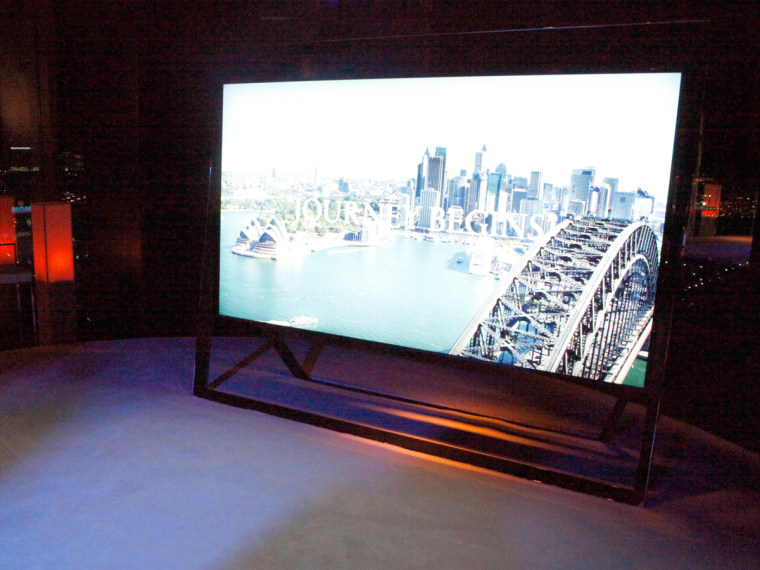TV makers have jumped through hoops trying to add new features to TVs in order to win customers who have been, until now, content with the big, cheap, low-on-features flat panels they find at price clubs and big boxes. Smart TV, 3-D TV, TVs with built-in cameras. These have all been tried. But the next innovation, called “ultra high definition” might be the innovation that will really catch on.
Late last year, Sony and LG begin shipping the first televisions with four times the definition of ordinary HDTV, as 84-Inch models with retail prices of $20,000 to $25,000. This year, nearly every name in TV including Samsung, Panasonic as well as lesser known players Westinghouse, Hisense and others are introducing these Ultra High Definition TVs. Every TV has over 8 million pixels, and screen sizes range from 50 to a whopping 110 inches. Can these super-sized sets create new consumer demand, and encourage the most affluent TV buyers to upgrade?
Why UHD TV?
These new screens are the TV equivalent of the iPhone’s “Retina” screen: They have pixels so small they are practically invisible, unless you nearly stick your nose up against the screen. And like those super-high-res screens now found on tablets, phones and computers, these serve a purpose even when the content doesn’t have that native resolution.
It will be some time before we can expect to buy or download major motion picture releases in this format, but TV makers have made major improvements in the signal processing called upconversion, which ups any content (standard or high def) to UHD resolution of 3840 x 2160.
From a manufacturing perspective, this seems less like a gimmick and more like a step in the right direction. If you want to make 1080p televisions at larger and larger sizes, you have to keep increasing the size of the individual pixels. With UHD, TVs can be much larger, while the individual pixels remain small — and sometimes get smaller.
Despite all of this, at HD Guru, we were very skeptical about UHD performance until we tested the LG 84LM9600 84-incher a few weeks ago. One of the issues we’ve had over the last few years was the lack of improvements in the display of standard or HDTV images.

While one can buy a high-def, Blu-ray disc, many are choosing instead to watch movies with services like Netflix. Web streaming of the same 1080p movie requires compressing the images down to fit over the Internet, and TV makers appeared to halt development of new algorithms and faster CPUs required to improve streamed content. Frankly, most of it looks pretty bad on any screen 40-inches or larger.
We were blown away by the new signal processing within LGs UHD TV. It aced all our HD test discs and looked fantastic on native high-definition content. Because of the high pixel density, UHD TV is best when viewed at about half the optimum distance of HDTV. The 84-incher can be viewed as close five and a half feet. As you can imagine, this gives you a totally immersive experience, almost like having an IMAX theater in your house. LG also showed us some native UHD content and we were completely blown away.
3-D perfected
While passive 3-D uses the same lightweight 3-D glasses as most movie theaters, in the home it suffers because it’s just half the resolution of a full HD picture. There’s also annoying line structure, “cross-talk” ghost images and a lack of brightness. UHD solves all these problems. The LG UHD TV (and we expect all the others) provides the finest 3-D images we’ve seen. It’s so good we recommend readers give 3-D a second look — when they can get hold of a UHD TV to try out.
Pricing and sales
While the first LG and Sony models are in the stratosphere of TV pricing, even for early adopters, the 2013 entry of smaller panels coupled with competition from Samsung and Chinese LCD panel makers should result in prices dropping quickly through the year and beyond.
You may have heard about another high-end TV technology, OLED. Where does it fit in? LG just announced the price of its 1080p OLED TV as $12,000. OLED may well prove to be the future of TV display technology, but it will mature over a period of several years before it's priced for anyone but the richest videophiles. UHD will reach maturity faster.
Worldwide sales this year will be limited to around half a million units. However, sales are expected to grow to over 2 million in 2014 and around 4.5 million in 2015, according to TV marketing research firm DisplaySearch. HD Guru predicts US UHD TV pricing will drop to around $4,000 for the smallest screen sizes (50 to 55-inches) by the end of 2013. And because nobody will spend top dollar on a 1080p TV when there’s a better resolution in town, we predict that by next year, all the top TV models will be UHD TV.
Have a question for the HD Guru? Send an email.
- Panasonic’s 2013 LED LCD line revealed
- LG To Ship The First Large Screen OLED HDTV Next Month
- HDTV Predictions for 2013 and CES
Copyright ©2013 HD Guru Inc. All rights reserved. HDGURU is a registered trademark.